‘Like Two Scorpions In A Bottle’: The 80th Anniversary Of The Invasion Of Peleliu
Those marginally familiar with World War II will no doubt recognize names like Normandy, Iwo Jima, or Guadalcanal. But like many of the other battles into which American boys have been thrown over the centuries, only the most ardent history buffs can relay much, if anything, about the agony that was the struggle for the ...
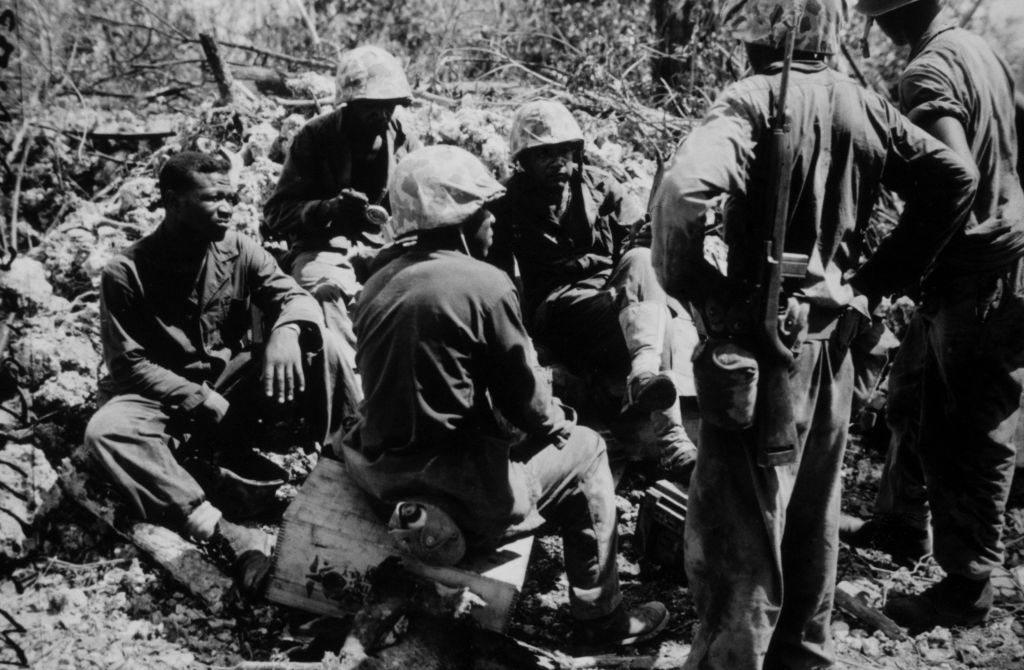
Those marginally familiar with World War II will no doubt recognize names like Normandy, Iwo Jima, or Guadalcanal. But like many of the other battles into which American boys have been thrown over the centuries, only the most ardent history buffs can relay much, if anything, about the agony that was the struggle for the island of Peleliu.
This month, we mark the 80th anniversary of the September 1944 landings on Peleliu in the Palau Island chain by the First U.S. Marine Division during the Pacific War. Peleliu is one of those battles that often gets passed over in our national memory.
In the fall of 1944, the island’s airfield was considered vital to protect MacArthur’s southern flank in his advance towards the Philippines 600 miles farther west. And so the First Marine Division was sent to this 14 square-mile dot in the Pacific to seize and clear the island of its estimated 14,000 Japanese defenders.
The operation, prophetically code-named Stalemate II, was expected to last a mere three days.
It didn’t.
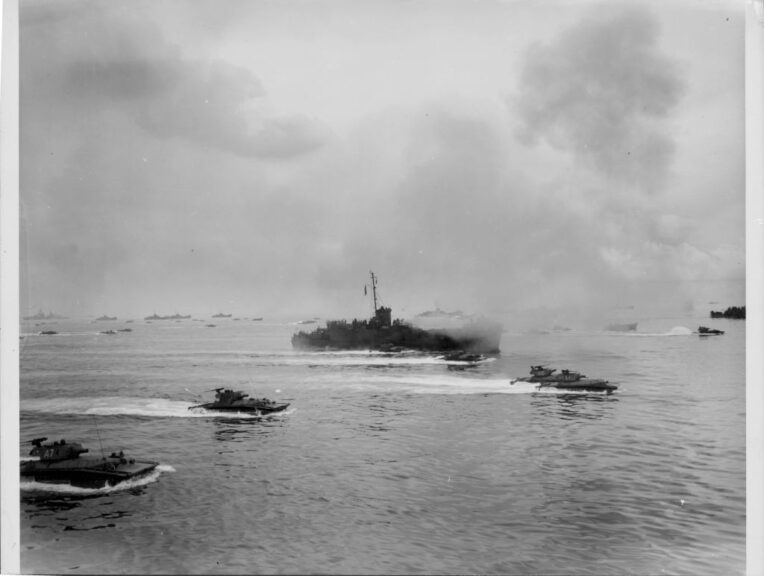
US ships and landing craft heading towards Peleliu Island during the Pacific Campaign of World War Two, Palau, September 5th 1944. (Photo by US Navy/Getty Images)
The Japanese, mimicking a new and bloody strategy first utilized on Biak several months before, did not meet the Marines on the beaches with anything but a skirmish line of machine guns, mortars, and well-sighted artillery. (Although for the men who landed ashore that day, the carnage and mayhem of this initial action would haunt them forever.) Nor would they waste themselves on mass Banzai charges that were methodically mowed down by the entrenched Americans as occurred on Saipan. Rather, the real battle for Peleliu would be fought against a tenacious enemy burrowed deep into the island’s rock-hard coral ridges, hidden within a network of caves, bunkers, pillboxes, and interconnected tunnels whose often steel doors were impervious to even the heaviest caliber naval gunfire. The U.S. military had never fought such a tenacious defender before. Said one Marine veteran, “Peleliu was, I think, the biggest surprise the Marine Corps received during World War Two.”
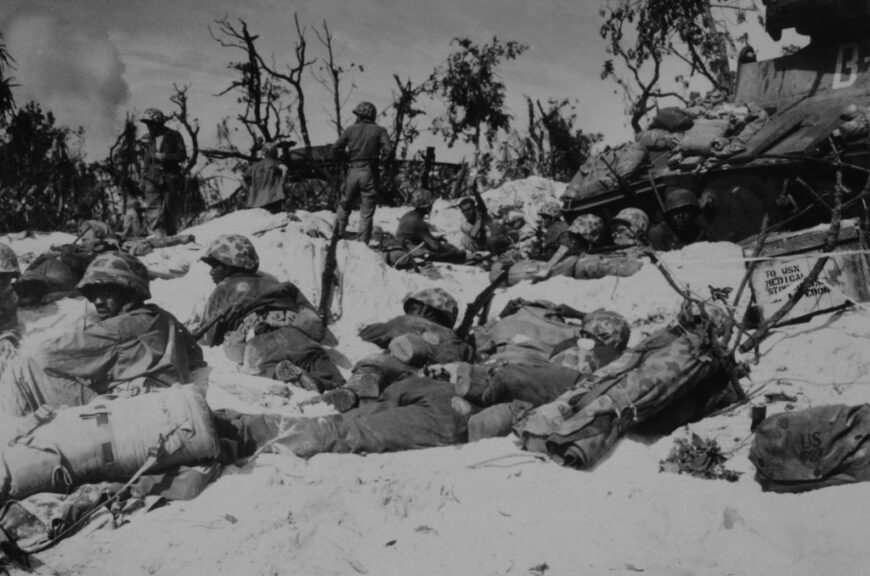
Archive Photos/Getty Images
The Americans found themselves shelled and fired down on without rest from Japanese gun emplacements dug into the sides of the forbidding Umurbrogol Ridge, a limestone outcropping some 550 feet above sea level which ran down the middle of the island like the vertebrae of a malevolent beast. As such, Japanese defenders had to be methodically rooted out, one position at a time, with small arms, grenades, demolition charges and, most terrible, flamethrowers while Marine and Navy fighter-bombers dropped canisters of napalm on Japanese positions. It was a brutal affair that went on for 73 tortuous days. In the process, the Marines and their Army replacements suffered crippling casualties.
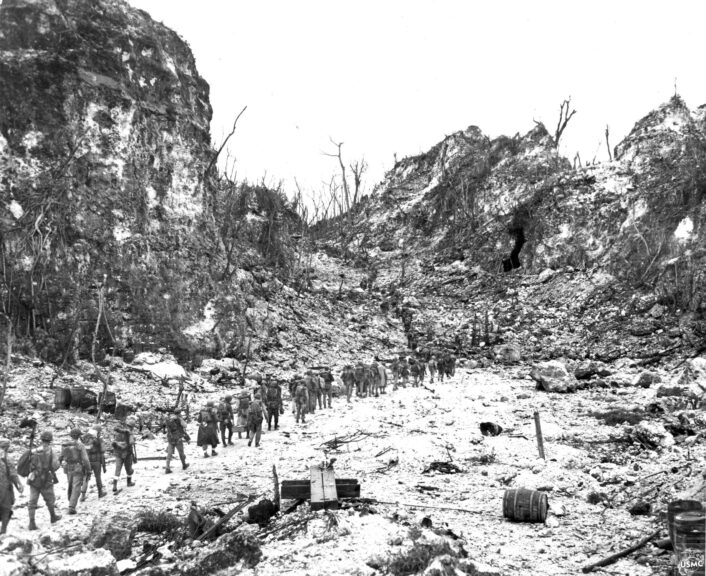
A column of Marines marches toward the front line through a defile at the southwestern end of Peleliu’s Bloody Nose Ridge. (U.S. Marine Corps). U.S. Naval Institute.
When a journalist caught up with an exhausted file of Marines rotating off the sheer coral escarpments that dominated the island, he asked them if this was the 1st Marine Regiment. “Mac, there ain’t no more 1st Marines,” a grim veteran replied.
Along with the agony of battle itself, the Americans also found themselves in a struggle with Peleliu’s forbidding topography and climate. The coral base of the island was too hard to dig adequate foxholes, or bury the dead, so many a combatant had to share what little shelter he could find with the bloating, maggot, and fly-infested corpses of enemy and friend alike strewn across the open ground. Adding to the misery, the temperature at times rose to 115 degrees in the shade, and the omnipresent vile stench of rotting flesh and swamp was thick in the oppressively humid air. Some veterans even wondered if they’d ever be able to get the odor out of their nostrils.
For the first few days of the battle, fresh water, a life-and-death matter in such tropical heat, was scarce; as if just to twist the screws, what water the Marines did receive was fouled by traces of fuel oil and rust residue from the reused oil drum containers that had been inadequately cleaned before being repurposed, adding vomiting and aggravated innards to the experience.
Through September, into October, then November the fighting dragged on, and casualties on both sides mounted. Part of the reason for the protracted and bloody nature of the battle was that arguably the two ablest fighting units of each country, the American First Marine Division and the Japanese 14th Infantry Division, faced off in this ghastly arena.
The Japanese were especially driven by a fanaticism to die for their god-emperor and a military code that viewed surrender as the worst of disgraces. Trapped on an island with no escape, the Japanese commander, Col. Kunio Nakagawa, steeled his men to sell their lives dearly, vowing to fight to the last man and take as many Americans as possible with them along the way. For the Marines and soldiers, any pretense of quarter was quickly abandoned in the see-saw fighting as they came across the bodies of captured comrades who’d been sadistically tortured and mutilated or tied to trees and used for bayonet practice. And given the Japanese penchant for trickery by feigning injury or death only to then detonate hidden grenades, blowing apart both themselves and the unsuspecting corpsmen or medics ostensibly coming to their aid, no one was in a mood to take prisoners.
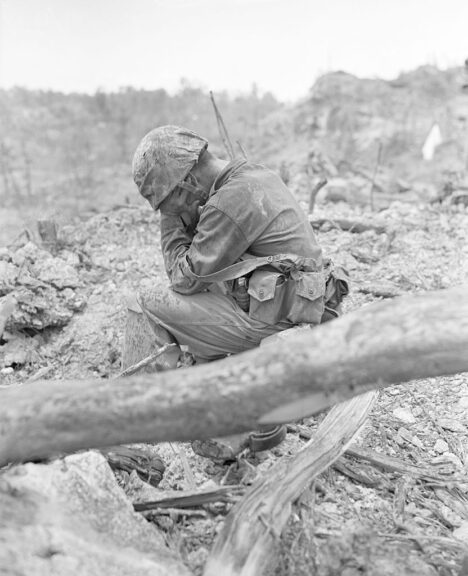
(Original Caption) 9/26/1944-Peleliu Island: Weary and exhausted after the tough battle for Hill 200 Near Peleliu Airport, this leather neck sits down amidst the battle rubble and weeps. According to latest reports, the marines are making steady progress on the Island, although heavy fighting continues.
Indeed, by 1944, both side’s combatants had for years been marinated in the notion that the enemy belonged to an inferior species. A Japanese newspaper once described the U.S. Marines as “a special force recruited from prisons and insane asylums for bloodlust”. As such, Peleliu was a place where courage was paramount and devotion to the man sharing your foxhole sacrosanct, but where chivalry was replaced with visceral, and understandable, loathing. A reductive atavism fueled by both dehumanizing propaganda and the realities of a medieval brand of warfare experienced day in and day out in an endless battle of attrition.
As with so many of these Pacific Island battles, the rules of warfare as dictated in the Geneva Conventions were ignored.
“The hatred was so intense,” remembered Marine Pvt. Eugene Sledge, that to him Peleliu was like “two scorpions in a bottle. One was annihilated, the other nearly so.”
Finally, on 27 November, 1944, D+72, after more than two months of non-stop fighting from one end of the superheated rocky island to the other, Peleliu was declared secure. Operation Stalemate II had taken an agonizing 70 days longer than confident planners had predicted. And both sides paid a horrific price for their efforts.
Of the 28,000 combined Marines and Army infantry involved, they incurred the highest American casualty rate of any amphibious landing of the war. The fine First Marine Division was shattered. It suffered 1,252 KIA and 5,274 wounded. The Army’s 81st Infantry Division lost another 542 KIA and 2,736 wounded.
The Japanese garrison was effectively wiped out. Only 202 of the 14,000 defenders were taken alive and of them, only 19 were Japanese military; the rest were Korean and Okinawan laborers.
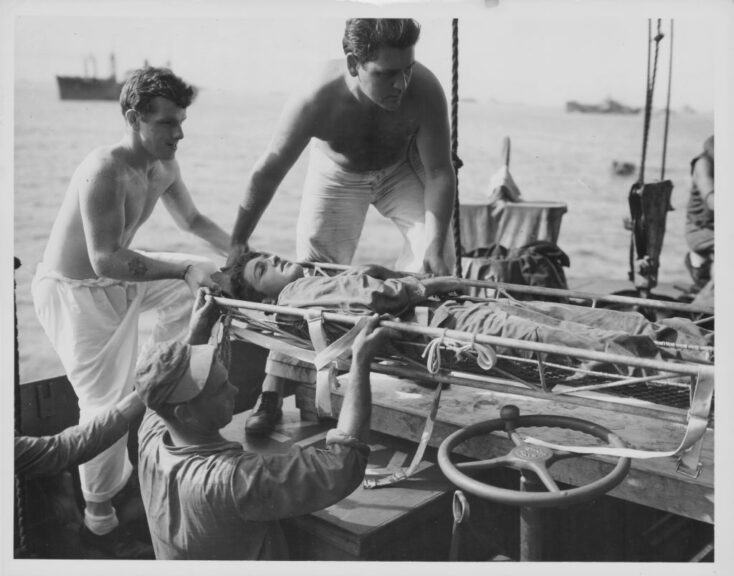
A wounded US Marine lifted aboard a Coast Guard-manned transport, during the Pacific Campaign of World War Two, Peleliu, Palau, 1944. (Photo by US Coast Guard/Getty Images)
Tragically, it is debatable whether Peleliu ever needed to be captured at all. The main purpose of the operation, to secure an aerodrome from which to cover the landings on Mindanao in the southern Philippines, was rendered of dubious value when MacArthur opted to bypass Mindanao and strike first at Leyte in the central part of the archipelago. Admiral William Halsey, in fact, had recommended the cancellation of the Palau landings in favor of using the Marines on Leyte. But, as author William Manchester, a wounded Pacific War Marine veteran himself, would bitterly write: “[Admiral] Nimitz decided it was too late to recall the Palau force and 9,171 [sic] Americans fell there, tragically and pointlessly.”
Since it was expected to be a quick, easy fight, few journalists bothered to cover the landings. Those who did found their stories overshadowed by events in the Philippines and Europe. In fact, the fighting on Peleliu was still raging when MacArthur’s invasion force hit the beaches of Leyte in October.
So Peleliu, perhaps the most brutal battle of our most brutal theater of war, remains in relative obscurity. The men who fought and especially those who died there deserve better. For many veterans who fought throughout the Pacific–the First Marine Division also saw action at Guadalcanal, Cape Gloucester, and Okinawa–Peleliu remained the battle that stayed with them in the sheer savagery of the action, hostility of the terrain, and abject misery of the conditions.
“Something in me died at Peleliu,” lamented Sledge, who’d somehow made it through 45 days of combat before his decimated 5th Marine Regiment was pulled off the line.
Whether or not the Marines and soldiers of Peleliu suffered and died needlessly, there is no debating whether they successfully carried out their mission with extraordinary bravery, skill, and perseverance. They did so on one of the most inhospitable battlefields into which men-at-arms have ever been placed, against an enemy whose homicidal fanaticism was matched only by their tenacity and skill as warriors.
Am I Racist? Is In Theaters NOW — Get Your Tickets Here!
We owe this moment, then, to the men of Peleliu, most of whom have now died from causes far removed from that terrible battlefield, to remember their sacrifice, to honor their courage, and give them one final salute as they move into their twilight.
Indeed, they should know they are not forgotten. They should know that the seminal moment of their young lives, one they carried to the end of their days, has not slipped away into the collective amnesia of a peaceful society. We will never fully comprehend what happened there and what they overcame to move the country one step closer to a just victory and the world to an enduring peace.
* * *
Brad Schaeffer is a commodities trader, columnist, and author of two acclaimed novels. Along with Daily Wire, his articles have appeared in the Wall Street Journal, New York Daily News, New York Post, National Review, The Federalist, The Hill and other media outlets. His newest book, LIFE IN THE PITS: My Time as a Trader on the Rough-and-Tumble Exchange Floors, is a fun and informative memoir of his time as a floor trader in Chicago and New York. You can also find more of Brad’s articles on Substack.
The views expressed in this piece are those of the author and do not necessarily represent those of The Daily Wire.
Originally Published at Daily Wire, World Net Daily, or The Blaze
What's Your Reaction?
































































































